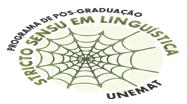Banca de DEFESA: PRISCILA APARECIDA MORAES HENKEMAIER XAVIER
Uma banca de DEFESA de DOUTORADO foi cadastrada pelo programa.DISCENTE : PRISCILA APARECIDA MORAES HENKEMAIER XAVIER
DATA : 07/10/2025
HORA: 14:00
LOCAL: Videoconferência
TÍTULO:
Toponymy in Libras in the State of Mato Grosso: an analysis of municipality signs
PALAVRAS-CHAVES:
Libras; toponymy; Deaf identity; bilingual education; Mato Grosso
PÁGINAS: 188
GRANDE ÁREA: Lingüística, Letras e Artes
ÁREA: Lingüística
SUBÁREA: Lingüística Aplicada
RESUMO:
This doctoral thesis, developed within the field of Applied Linguistics under the research line Studies of Social Language Practices at the Graduate Program in Linguistics (PPGL), aimed to analyze the signs that designate municipalities in the state of Mato Grosso in Brazilian Sign Language (Libras), seeking to understand their linguistic structures, semantic motivations, and communicative functions, based on the premise that they constitute relevant material for the study of toponymy in sign languages. The study explored central issues such as the mechanisms of creation of toponymic signs, their recognition and use by the deaf community of Mato Grosso, and the historical, geographical, and cultural aspects reflected in their forms. Inserted in an interdisciplinary framework combining linguistics, cultural geography, and deaf education, the investigation adopted a qualitative, descriptive, and interpretative approach, emphasizing the visual and multimodal analysis of signs. The corpus comprised 106 toponymic signs, considering that 10 municipalities presented two signs, collected through the actions of the Center for Deaf Services of Mato Grosso (CAS/MT). The methodology allowed for precise documentation of Libras linguistic parameters, mechanisms of iconicity, and borrowings from written Portuguese, with theoretical grounding in Dick (1990), Sousa (2019, 2022, 2025), Aguiar (2012), and Sousa; Quadros (2019a, 2019b, 2019c). Analysis showed that 63% of the signs present some type of linguistic borrowing—through initialization, calque, or transsemiotic processes – while 37% are considered native or pure, reflecting a balance between Libras’ internal creativity and Portuguese influence. Regarding semantic motivations, 65 grafematoponyms (65.61%), 7 zoonyms (7.6%), 7 signs with opaque motivation (7.6%), 6 ergotoponyms (6.6%), 4 hydrotoponyms (4.4%), 4 mimetoponyms (4.4%), 3 phytotoponyms (3.3%), and other categories—including corotoponyms, sociotoponyms, poliotoponyms, ecotoponyms, and transsemiotic motivation—were identified, along with cases of dual motivation. The results demonstrate that toponymic signs in Libras constitute a complex and dynamic form of naming, combining linguistic parameters intrinsic to Libras with semantic-visual motivations derived from local cultural, historical, and geographical aspects, in which iconicity plays a central role. This study highlights that signed toponymy functions as a visual record of local history, geography, and culture, contributing to the strengthening of deaf identity, the recognition of Libras as a full, autonomous, and historically situated language, and the preservation of the cultural and identity markers of the deaf community, while providing resources for systematic documentation of Libras and promoting linguistic and social inclusion.
MEMBROS DA BANCA:
Presidente - 466.104.133-04 - ALEXANDRE MELO DE SOUSA - UFAC
Interna - 131986001 - ERIKA REGINA SOARES DE SOUZA
Interno - 83247001 - WELLINGTON PEDROSA QUINTINO
Externo à Instituição - JOSÉ ISHAC BRANDÃO EL KHOURI - UFT
Externa à Instituição - MIDIAN JESUS DE SOUZA MARINS - UFRB



